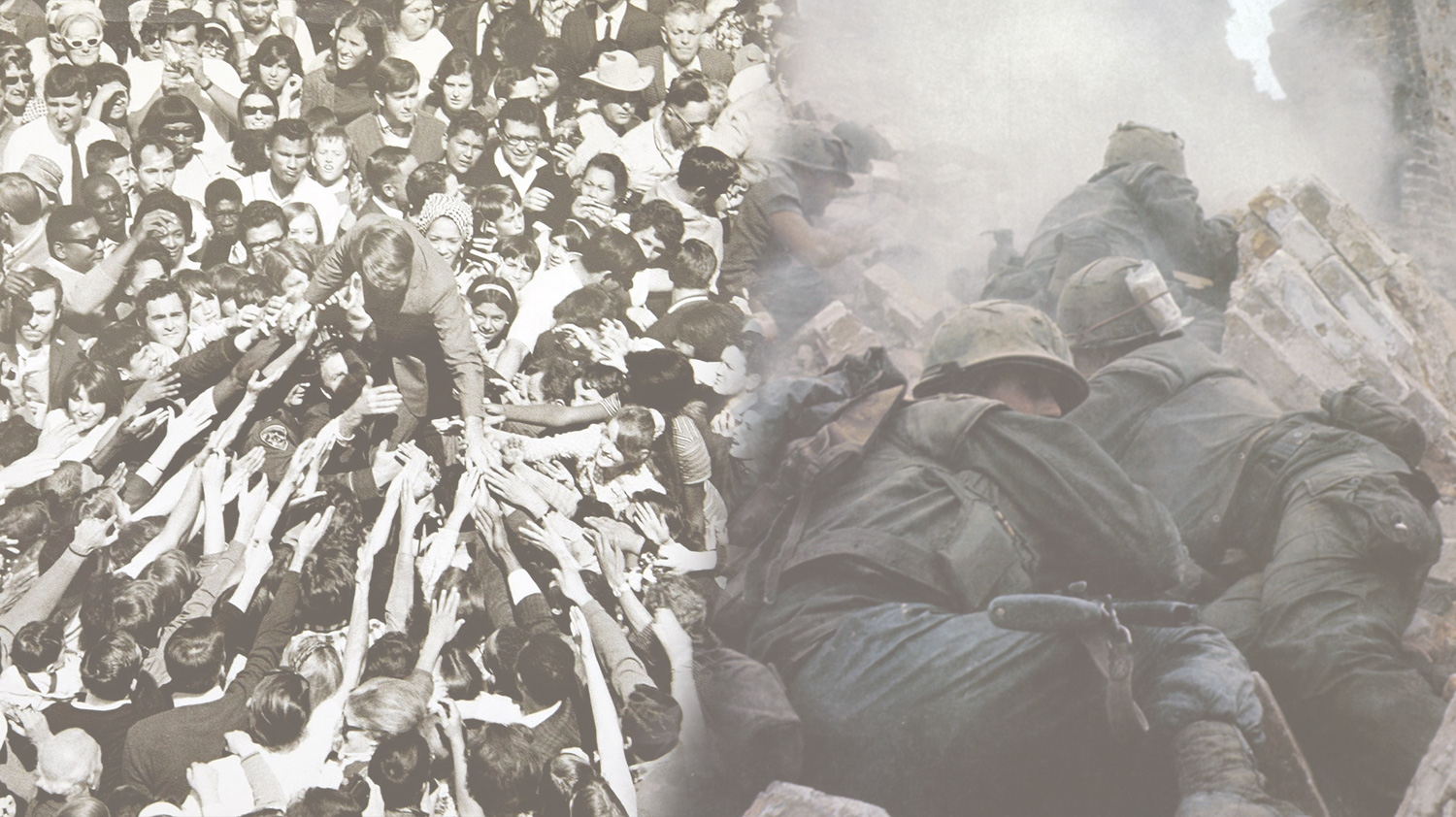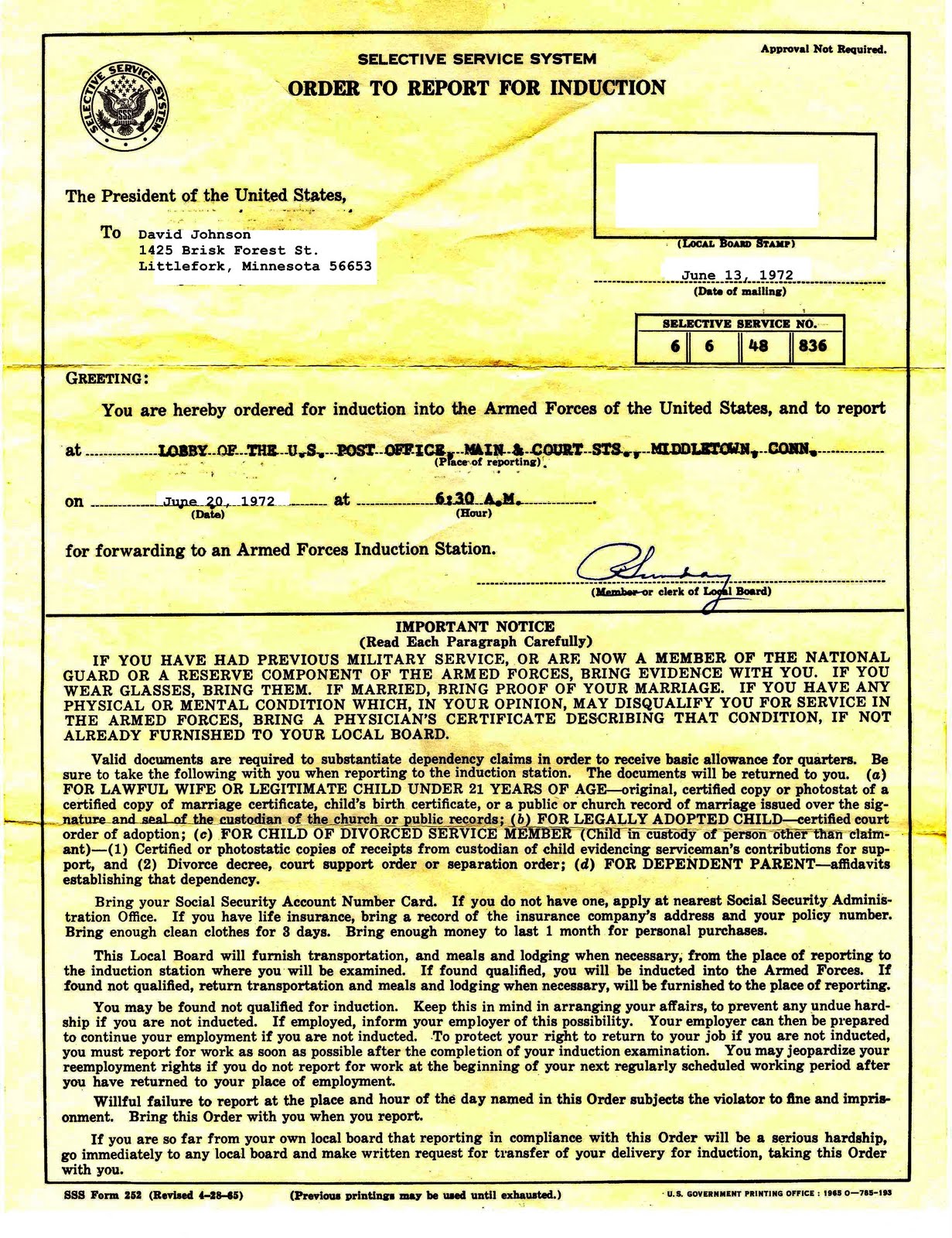- Smithsonian Magazine
- Vietnam Timeline
- Chicago '68 Project Blog - Dean Blobaum
- About.com
- NPR
- PBS - The American Experience
- The Nixon Presidential Library & Museum
Written by Molly Swift on November 15, 2013.
The Gates Commission was the deciding factor in removing the draft from the Army recruitment process. Gates was quoted as saying "The cost of an all-volunteer force was "a necessary price of defending our peace and security [and that conscription was] . . . intolerable when there is an alternative consistent with our basic national values." These rights, as Brooks understands it, are the rights we have according to our constitution; our freedom and our right to vote and to choose. “The Commission did find in their feasibility study that many of the people interviewed would have volunteered if they were given a choice or the opportunity. However, the “law” was that all 18 year old males had to take a written test and a physical in preparation for the draft. Conscription in itself is immoral and certainly inequitable – it was also ineffective, inefficient and detrimental to national security, according to W. Allen Willis.”
Speaking to Brooks about the drastic departure from conscription to an all volunteer Army, it is clear that the change was much needed. Certainly, the late sixties impacted the public’s perception of the Armed Forces. It was, as Tom described to me, a perfect storm; the draft, the assassinations, the anti-war movement and public riots simply meant people were disgusted with the way things were going in the United States. Vietnam was not a declared war, it was a conflict, and the public understood the Army was selecting its conscripted Soldiers from the poorer sectors of society who were subsequently quickly and poorly trained – sometimes on equipment they wouldn't encounter while in combat – before being shipped off to Vietnam as a sacrificed population.
The Vietnam conflict took thousands of young American lives – according to archives.gov, 58,220 died during the conflict. Brooks said, “It was an unpopular conflict which started with advisers, a few Special Forces troops and then escalated thanks to a few political players. Feeding this demise was the draft – thousands drafted, sent to basic training and AIT, home on leave for a couple of months and then onto Southeast Asia. None of the training received was directly related to relative to guerrilla warfare or insurgent warfare. Yes. The men who were drafted that way were sacrificed. Ending the draft stopped the flow and people began to think rather than just react.”
Public perception also drew a connection between the draft board and Vietnam. The Selective Service System (SSS) was a never ending cache of new blood, and the SSS as subjective as it was selective – local draft boards decided who would be drafted and who wouldn't. According to Brooks, if you lived in Mississippi and you were African American or poor white, you were drafted. “Most people don’t know, but prior to abolishing the draft, President Nixon’s policy was no draftee would be sent to Vietnam unless they volunteered – only regular Army volunteers were sent to Southeast Asia.”
The proposed all-volunteer Army met with huge resistance in the “Real Army” and mostly from those who had benefited from the old structure. General Hershey objected to an all-volunteer military, saying the "presumption that the national security can be maintained by armed forces provided by added pay incentives is based on hopes that have not been sustained by the history of the United States." But at the time military pay was well below minimum wage and far less than earned by civilians. Brooks was being paid $73 a month. Hardly an incentive – definitely not the incentive that drove him to carve out a career in the Army!
Major Neal G. Sorensen said a "volunteer military might tend to become a more self-contained establishment, the danger being if a professional volunteer military began to see itself as distinct and alienated from society." The career Army Soldiers were resistant to the change since it challenged their abilities and the way they were accustomed to doing things. Change isn't easy for most people, but some have a harder time than others!
Brooks puts it even more simply. “A conscript was totally the property of the people in charge of him. Now volunteers are coming, the leaders have Soldiers who might question them, and the “lifers” didn't like that. I believe the Army is a society within a larger society, but one that has ethics and is wholesome. Not separate, but a role model for what a society should be. There were some who thought that higher paid volunteers would be akin to a mercenary force, which is definitely not the case! Abolishing the draft was fought by the lowest private to some of the highest ranking generals!”
So, did the introduction of the all-volunteer system obviously ease civil-military relations? Were the benefits immediately apparent? Well, yes and no.
Though the benefits of a Voluntary Army were immediately apparent it took time for the nation to adapt. Because the conscription culture was deeply embedded in America and due to the lack of instant news coverage, email, or the internet, Brooks found that years after the draft ended he would encounter people in his recruiting office asking when they would be drafted. On a social level, the changes were even more obvious – in 1973 the draft ended, the POWs were released from North Vietnam and two years later the conflict was over. Now there was nothing to protest and riot about.
1968
In October of 1967, a series of "Stop the Draft" protests were conducted throughout the United States. Thousands burned or turned in their draft cards as a demonstration of resistance and in defiance of the established draft process. The following eight weeks were filled with increasing numbers of activist gatherings and demonstrations; during one such protest in late October organized by the National Mobilization to End the War in Vietnam (MOBE), 100,000 attend. Afterward, MOBE began to promote antiwar protests during the 1968 Democratic National Convention, where President Johnson was expected to be nominated for a second term.
“As 1968 began, greater shocks awaited the nation: North Vietnamese forces launched the Tet offensive that January, rocking U.S. troops and shattering any notion that the war was nearly won. Johnson withdrew from the presidential campaign that March. Martin Luther King Jr. was assassinated in Memphis in early April, and another succession of riots swept the cities. Robert F. Kennedy, heir to the Kennedy legacy, had his presidential campaign cut down by an assassin's bullet after winning the critical California primary in June.” (Smithsonian)
The following time-line of 1968 events illustrates how rapidly the American people were confronted with consecutive, tumultuous changes during 11 months of that year. We've expanded upon a few key moments:
January
North Vietnamese Launch Tet Offensive: In a show of military might that catches the US military off guard, North Vietnamese and Vietcong forces sweep down upon several key cities and provinces in South Vietnam, including its capital, Saigon. Within days, American forces turn back the onslaught and recapture most areas. From a military point of view, Tet is a huge defeat for the Communists, but turns out to be a political and psychological victory. The US military's assessment of the war is questioned and the "end of tunnel" seems very far off.
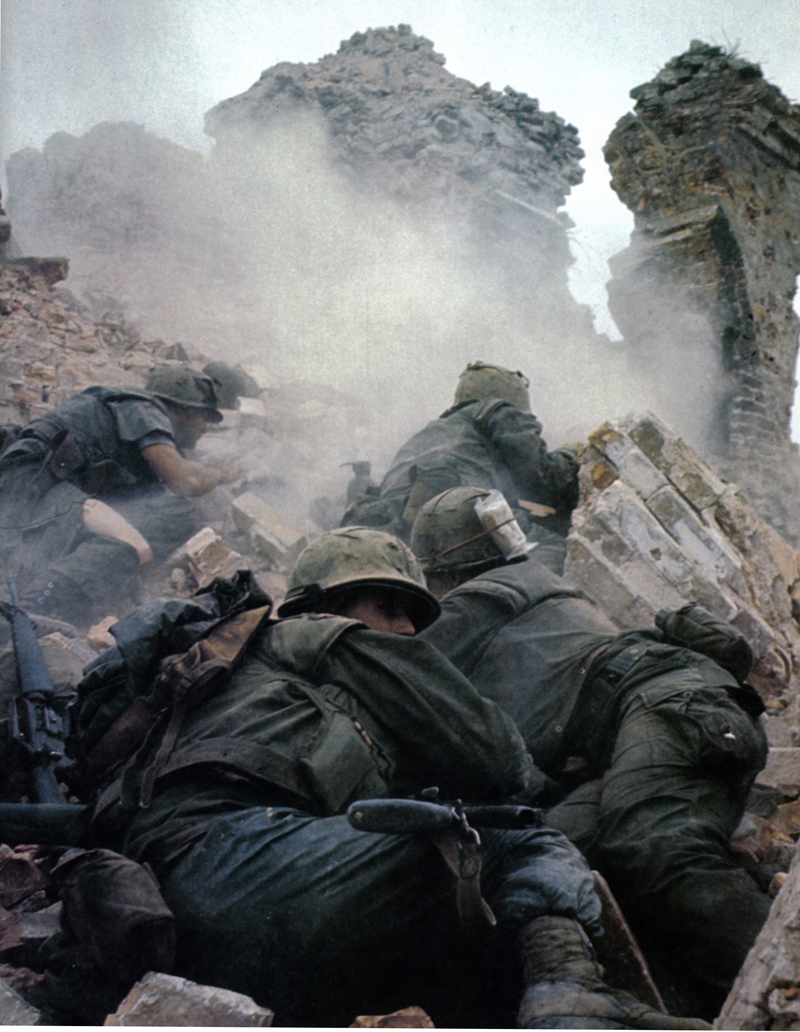
February
Battle for Hue: The Battle for Hue wages for 26 days as US and South Vietnamese forces try to recapture the site seized by the Communists during the Tet Offensive. Previously, a religious retreat in the middle of a war zone, Hue was nearly leveled in a battle that left nearly all of its population homeless. Following the US and ARVN victory, mass graves containing the bodies of thousands of people who had been executed during the Communist occupation are discovered.
My Lai Massacre: On March 16, angry and frustrated men of Charlie Company, 11th Brigade, Americal Division entered the village of My Lai. "This is what you've been waiting for -- search and destroy -- and you've got it," said their superior officers. A short time later the killing began. When news of the atrocities surfaced, it sent shock-waves through the US political establishment, the military's chain of command, and an already divided American public.
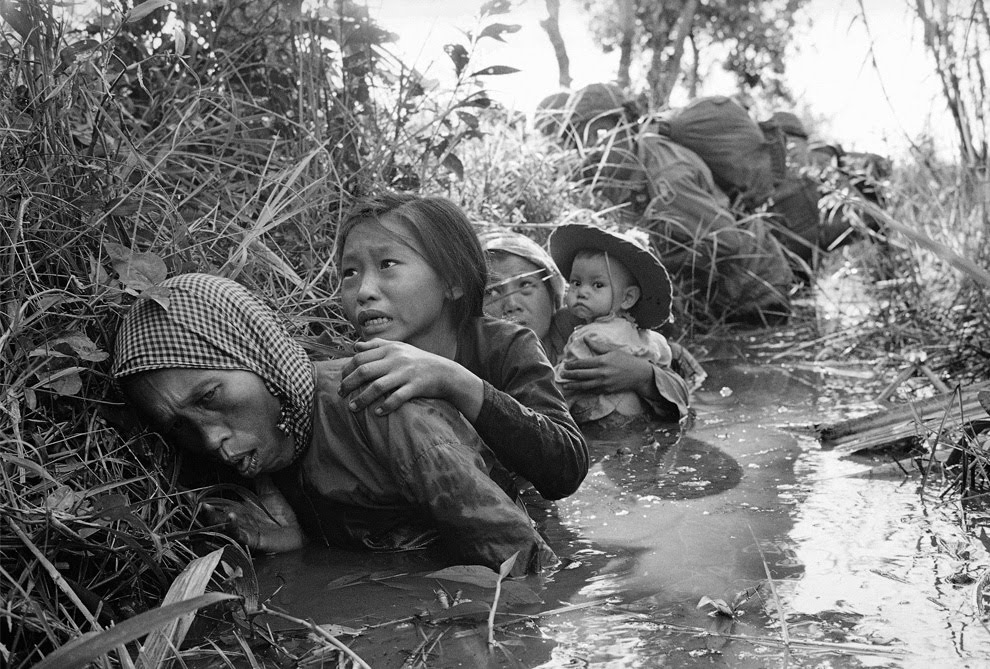
March
LBJ Announces He Won't Run: President Lyndon Johnson stuns the nation by announcing he "shall not seek" and "will not accept" the nomination of the Democratic Party for another term. The decision comes following a weaker-than-expected showing in the March 12 New Hampshire primary and the subsequent presidential candidacy of Senator Robert Kennedy of New York. It also comes as the nation remains deeply divided over what to do in Vietnam. Johnson's bombshell came at the end of a nationally televised policy statement in which he announced the halting of bombing raids over North Vietnam.
April
MLK Slain in Memphis: At 6:01 p.m. on April 4, 1968, civil rights leader Dr. Martin Luther King Jr. was hit by a sniper's bullet. King had been standing on the balcony in front of his room at the Lorraine Motel in Memphis, Tennessee, when, without warning, he was shot. The .30-caliber rifle bullet entered King's right cheek, traveled through his neck, and finally stopped at his shoulder blade. King was immediately taken to a nearby hospital but was pronounced dead at 7:05 p.m.
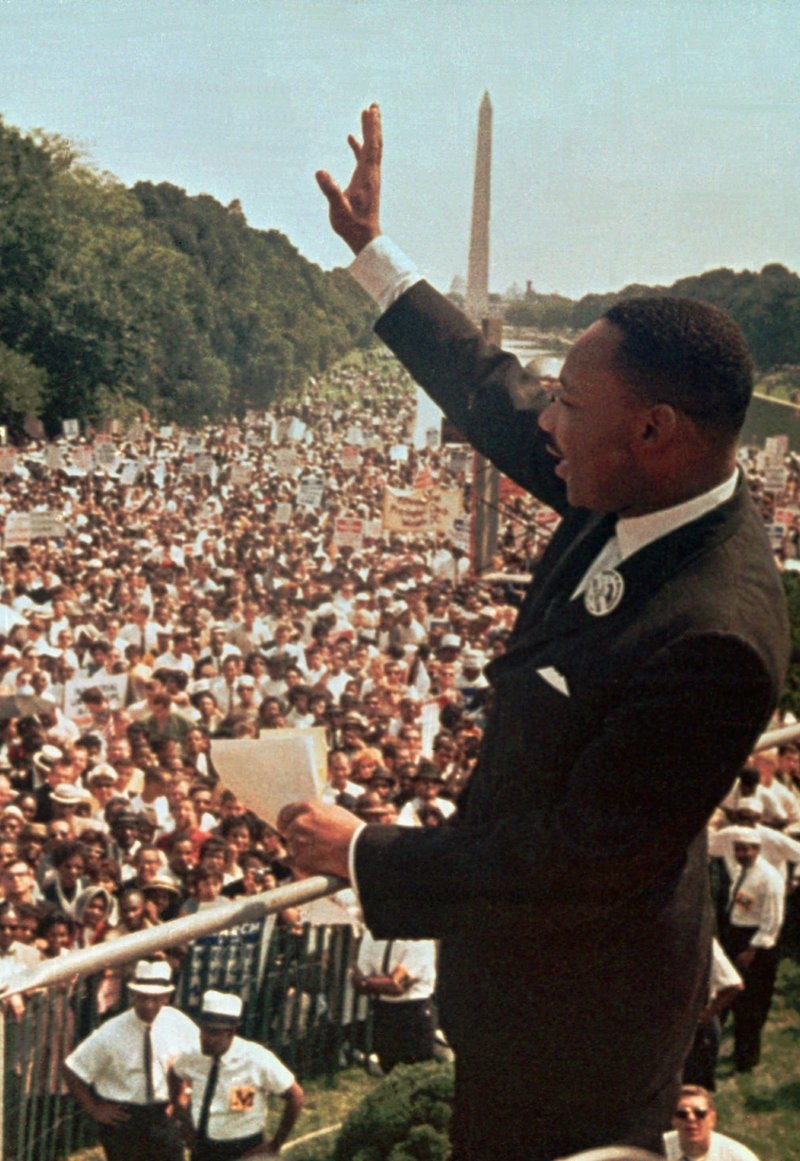
May
Paris Peace Talks Begin: Almost as soon as the talks were started, they stalled. When President Lyndon Johnson turned over the presidency to Richard Nixon eight months into the talks, the only thing the two sides had agreed on was the shape of the conference table. (Despite candidate Nixon's promise of "peace with honor," the deadlock would continue for three-and-one-half years of public and secret meetings in Paris.) Two key issues had locked both parties. Washington wanted all northern troops out of South Vietnam; Hanoi refused any provisional South Vietnamese government that involved its leader, Nguyen Van Thieu.
June
Robert Kennedy Assassinated: Shortly after midnight on June 5, 1968, presidential candidate Robert F. Kennedy was shot three times by Palestinian immigrant Sirhan Sirhan after giving a speech at the Ambassador Hotel in Los Angeles, California. Kennedy underwent a three-hour brain surgery, in which doctors removed bone and metal fragments. Over the next few hours, however, Kennedy's condition continued to worsen. At 1:44 a.m. on June 6, 1968, Robert Kennedy died from his wounds at age 42. The nation was severely shocked at the news of yet another assassination of a major public figure.

August
Upheaval at Democratic Convention in Chicago: As the frazzled Democratic party prepares to hold its nominating convention in Chicago, city officials gear up for a deluge of demonstrations. Mayor Richard Daley orders police to crackdown on antiwar protests. As the nation watched on television, the area around the convention erupts in violence.
November
Richard Nixon Elected President: In the general election, Nixon emphasized "law and order" and hoped to position himself as the champion of the silent majority. He attempted to place less emphasis on the controversial Vietnam War by claiming he had a plan to end it. On Election Day the popular vote was close: Richard Nixon had 31.8 percent, Vice President Humphrey had 31.3 percent, and Alabama Governor George Wallace won 13.5 percent. But Nixon's Electoral College margin was substantial, 301 to 191 to 46. Despite the closeness of Nixon's victory, it was a resounding mandate against Johnson and the Democratic Party.
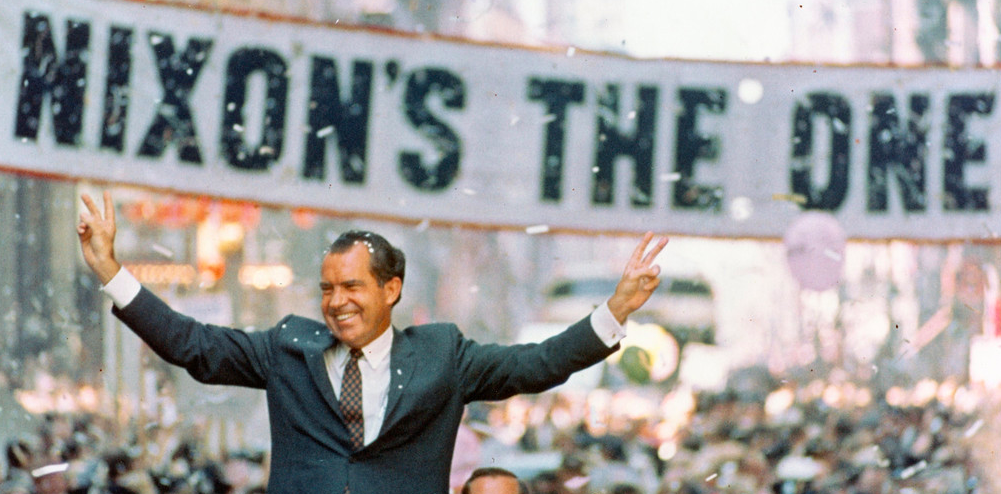
Sources:



